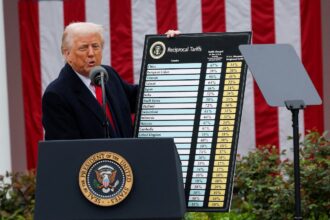The economic landscape between North America’s closest allies took another contentious turn this week as former President Donald Trump announced sweeping tariff plans that would significantly impact Canada, just days after the Biden administration imposed its own duty increases on Canadian goods. This escalation marks a troubling pattern in cross-border trade relations that has analysts concerned about long-term economic implications.
“What we’re witnessing is unprecedented in modern North American trade history,” said Dr. Elena Mathews, senior economist at the Canadian Economic Forum. “Two consecutive administrations taking hardline approaches against their largest trading partner signals a fundamental shift in how the United States views trade relationships.”
The Trump campaign’s proposed 10% universal tariff on imports—rising to 60% on Chinese goods—comes as Canadian businesses are still calculating losses from the Biden administration’s aluminum duty hikes. These back-to-back actions have sent shockwaves through Canadian markets, with the Toronto Stock Exchange experiencing significant volatility as investors reassess cross-border business prospects.
Manufacturing sectors appear particularly vulnerable. Windsor’s auto parts industry, already operating on thin margins, faces potential devastation if both tariff regimes take full effect. “We’re looking at potential layoffs of 15-20% of our workforce if these tariffs stick,” revealed Michael Donnelly, operations director at Ontario Auto Components, a major supplier to North American vehicle manufacturers.
The economic data paints a concerning picture. Canadian exports to the United States totaled $476.1 billion in 2023, representing 75% of Canada’s total exports. The Department of Finance estimates that every percentage point increase in tariffs could reduce GDP growth by 0.3%, potentially eliminating thousands of jobs across multiple sectors.
International trade experts note this represents a broader shift in American trade policy. “We’re seeing the death of the post-WWII trade consensus,” explained Dr. James Crawford of the International Trade Institute. “Both major American political parties are now embracing protectionism, though with different justifications and implementation strategies.”
The Canadian government has responded with measured diplomacy while preparing potential countermeasures. Prime Minister Justin Trudeau emphasized the integrated nature of North American supply chains during a press conference in Ottawa yesterday: “When we erect barriers between our economies, we don’t just hurt each other’s businesses—we raise prices for our citizens and make our entire continent less competitive globally.”
Behind closed doors, sources indicate Canadian trade officials are preparing targeted retaliatory measures focused on politically sensitive American industries, similar to the strategy employed during previous trade disputes. The approach aims to maximize political pressure while minimizing economic damage to Canadian consumers.
Meanwhile, across the global economy, reaction has been swift. The European Union, Mexico, and Japan have all expressed concern about the cascading effect of American protectionism, with several nations beginning preparations for World Trade Organization challenges.
For everyday Canadians, the immediate impact will likely appear at retail checkout counters. Economic models suggest consumer goods could rise 5-8% in price if both tariff plans are fully implemented, affecting everything from household appliances to food products. The timing is particularly problematic given persistent inflation concerns.
Small businesses near the border face particular challenges. “We’ve survived COVID, supply chain disruptions, and labor shortages,” said Jennifer Pierce, who owns a manufacturing business in Niagara Falls, Ontario. “But these tariff wars might be what finally breaks us. We simply can’t absorb these additional costs.”
As the situation continues to evolve, one question remains at the forefront of economic discussions: In an era where global challenges demand unprecedented cooperation, can North America afford the luxury of trade wars between its closest allies?














